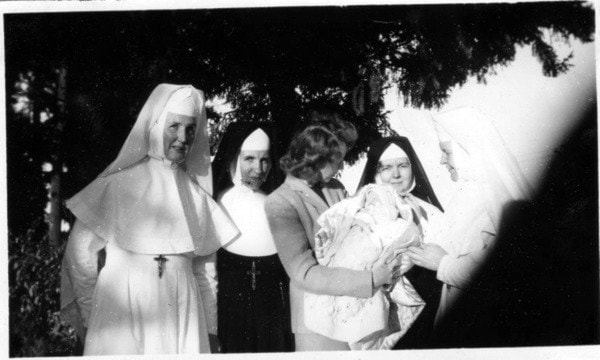Each month until July the Comox Valley Record is featuring historical information about St. Joseph's General Hospital in Comox, which is celebrating its 100th year.
St. Joseph's General Hospital was created for the community, but it was enhanced — and continues to be enhanced — by the community.
The reciprocal nature of the hospital providing care to the community and the community providing care for the hospital is easy to see throughout its history in the Comox Valley.
First of all, the hospital was physically built, and expanded repeatedly throughout the years, thanks to the teamwork of the Sisters of St. Joseph of Toronto and members of the community, among others.
"The process of founding and developing this western hospital has involved sacrifices, but they were sacrifices cheerfully made and generously shared by others, as well as by members of the community," is a passage in an archived summary of hospital annals from 1913 to 1940.
"The sisters themselves maintain that the reward has been very great, and not the least part of it has been found in the splendid co-operation and friendship of the good people of Comox, non-Catholic as well as Catholic."
From farmers to businessmen, many community members jumped in to help on the hospital board. The 102nd Battalion of 1,200 men stayed in Comox for some time during the First World War and some members helped clear land daily and assisted in other ways.
Through her research, St. Joseph's centennial co-ordinator Mary Lee has found many other stories of how the community helped the hospital in whatever way they could.
"I've heard stories such as the fishermen that used to bring fish to the sisters so that they could make themselves a meal, stories of, in the '50s, the Cocoa Man that used to bring cocoa to the patients," says Lee. "And then, I just recently heard a lovely story of a family that would come out over Christmastime and bring gifts of goodies and treats and spend time with the patients in extended care."
The sisters returned these acts of kindness through their own acts of kindness and understanding. According to a hospital archivist, there were many instances where families did not have the cash to pay for their hospital care during the 1920s and '30s and, as there was no medicare then, the sisters would trade goods and services for the care.
Sacks of potatoes, other vegetables, meat and whatever else people had, would commonly be traded for medical care during this period.
Meanwhile, some people would work at the hospital to "pay" their bills.
In one case a mother died of phlebitis when giving birth at the hospital. Because the family was then motherless, the baby stayed at the hospital for an extended time while the Sisters of St. Joseph taught older girls in the family how to care for the new baby. One of the older girls then worked at the hospital to pay off the bills.
Lee notes community members fundraising for equipment and supplies for the hospital started back in 1914 when the Women's Auxiliary, which is now known as St. Joseph's Hospital Auxiliary, formed.
"Their mission was to just do that, to fundraise and have teas and just do little small things to bring a little bit more to the hospital, to the patients, and to enhance the hospital through financial means," says Lee.
"Now today, they have the hospital foundation who fulfills that role of reaching out to the community to find donors, and reach into the community for donations to help fund much-needed equipment, so really this hospital's all about a sense of community — fulfilling the health-care needs of the community and the community giving back."
After a particularly large hospital expansion in the late 1960s, hundreds of community members attended the grand opening of the 'new' hospital, according to a newspaper clipping from that time titled 'The meaning of the new hospital.'
St. Joseph's General Hospital "represents, even as we do, those who laboured before us to make what we fashioned today possible. It represents heartbreak, frustration, self-denial, futility — all the ingredients those good people of the past must have felt as they groped to make the best out of what they had which, in many instances, no doubt, was not very much indeed, if anything," reads the newspaper clipping.
"Better still, however, St. Joseph's Hospital represents man's determination and faith, and refusal to give in but to push on knowing the need of the citizens of the Comox Valley and all others in search of health-giving medical attention."
writer@comoxvalleyrecord.com
